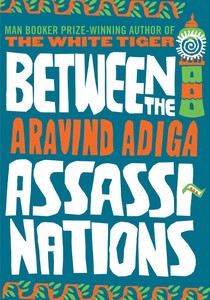 | Reviews of Between the Assassinations Aravind Adiga Penguin 2008 |
[This novel was shortlisted for the Best Book award in the South East Asia and the Pacific region of the 2009 Commonwealth Writers' Prize.]
From the publisher's page:
The dazzling new book from the winner of the 2008 Man Booker Prize: one of the summer's most eagerly anticipated works of fiction. In Between the Assassinations, Aravind Adiga brings to life a chorus of distinctive Indian voices, all inhabitants in the fictional town of Kittur... His new book sizzles with the same humour, anger, and humanity that characterized The White Tiger. On India's south-western coast, between Goa and Calicut, lies Kittur -- a small, nondescript every town. Aravind Adiga acts as our guide to the town, mapping overlapping lives of Kittur's residents. Here, an illiterate Muslim boy working at the train station finds himself tempted by an Islamic terrorist; a bookseller is arrested for selling a copy of The Satanic Verses; a rich, spoiled, half-caste student decides to explode a bomb in school; a sexologist has to find a cure for a young boy who may have AIDS. What emerges is the moral biography of an Indian town and a group portrait of ordinary Indians in a time of extraordinary transformation, over the seven-year period between the assassinations of Prime Minister Gandhi and her son Rajiv. Keenly observed and finely detailed, Between the Assassinations is a triumph of voice andReviews
imagination.
Nirpal Dhaliwal in "The London Evening Standard": "Having excoriated the pretensions and injustices of modern India, he's now written an historical piece situated between the assassinations of Indira Gandhi and her son, Rajiv, that ended the Nehru dynasty's 40year monopoly of Indian politics. Located in the fictional south Indian town of Kittur, it consists of a series of vignettes weaving together characters from a variety of castes, religions and backgrounds to give a textured and intimate sense of the exhausting complexity of Indian life and its stifling social attitudes -- very much like R K Narayan did with his Malgudi novels but with a dark and smutty sense of humour...Addressing India's strengths with the unsentimental candour that he applies to its weaknesses would be the mark of a pioneering novelist. Readable as his new book is, he missed an opportunity truly to become the trailblazer that many think he already is."
Susan H. Greenberg in "Newsweek": "Like an Asian sister city to Sherwood Anderson's Winesburg, Ohio, the fictitious town of Kittur, India, is full of anguished souls trying to find their place in the world. They fight, love and struggle their way through the overlapping stories in Between the Assassinations, the nimble new work from Aravind Adiga, the Indian writer who won Britain's Man Booker Prize last year for his savage first novel, The White Tiger. With his latest book, Adiga, 34, strengthens the brash voice that echoed through his debut...As literature, Between the Assassinations feels slighter than The White Tiger. But as a portrait of India, it's far richer and more nuanced, encompassing the perspectives of Muslims, Hindus and Christians; rich and poor; young and old; upper caste and lower."
Lee Thomas in "The San Francisco Chronicle": "Kittur is a microcosm of India as a whole: Deep divisions run along lines of caste, religion, class and politics; rapid modernization strains these traditional categories. In many ways, the vignettes in Between the Assassinations flesh out the question at the heart of The White Tiger: Where is the justice in one man ruling another simply though the accident of his birth? Welcome to most of human history...The stories provide an intimate setting for revelation. Like passing through a congested street on a rickshaw, the reader encounters all quarters of the city, all strata of the populace."
Peter Parker in "The Sunday Times": "Once again, Adiga concentrates on the inequalities between rich and poor, employers and employees, servants and those they serve, and many of the stories deal with the problems of caste. He has said he wants to portray the underclass that forms the vast bulk of India's population -- and when he turns his attentions to the well-off pupils at St Alfonso's Boys' High School or the denizens of a salubrious suburb at the edge of a forest, the stories are less engaging...Adiga is at his best when describing the everyday realities of village people who escape to a big city, or are sent there by their families, and end up living on the streets and doing the most menial jobs."
Short notices
Chandrahas Choudhury on the "Good Read" weblog: "On a map of India Kittur would only be a finger-joint away from R.K. Narayan's Malgudi, but the savagery of Adiga's material and his slashing style make for an atmosphere worlds away from the older writer's gentler ironies and greater tolerance for life's injustices. Adiga's great theme is power relations -- between rich and poor, master and servant, high caste and low caste, majority and minority -- and, as a consequence of these relations, moral perversion and subaltern rage."
The"Something about Everything" weblog: "The texture of Between the Assassinations is different from the The White Tiger but like it the lens is angled directly over India's social landscape.But the main theme, the one at which the author hacks away relentlessly, is that of power relations-rich-poor,high caste-low caste,majority-minority and last but not the least, between the English-speaking and those who can't, but are captivated by the aura of the language; as in case of Ziauddin, 'Whenever a word was said in English all work stopped, the boy would turn around and repeat the word at the top of his voice, "Sunday-Monday, Goodbye, Sexy!", and the entire shop shook with laughter.'"
